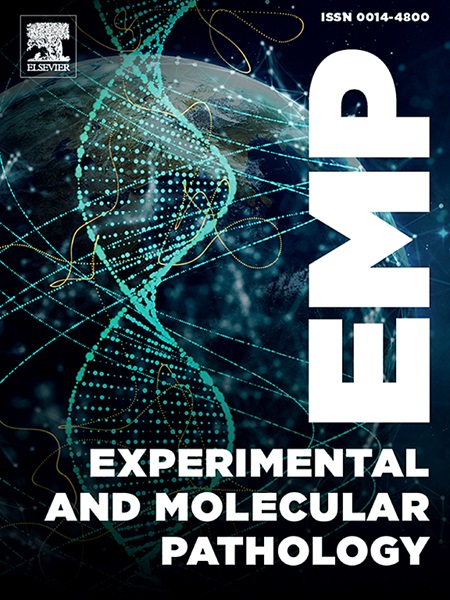小肠细菌加速阿司匹林引起的小肠损伤
IF 3.7
4区 医学
Q2 PATHOLOGY
引用次数: 0
摘要
背景:在肠包被低剂量阿司匹林(LDA)治疗过程中观察到小肠黏膜损伤,但机制不确定。由于阿司匹林(乙酰水杨酸,ASA)是高细胞毒性水杨酸(SA)的乙酰化形式,我们假设SA在小肠内被酯酶去乙酰化直接导致粘膜损伤。本研究探讨了ASA在小肠环境下脱乙酰化为SA的机制。方法在x细胞中加入ASA,观察其去乙酰化程度及细胞损伤情况。为了探讨ASA在肠道环境中的去乙酰化机制,我们将ASA与不同pH的磷酸盐缓冲液(4.01-9.10)、胰腺酶、胰腺和IEC-6细胞匀浆以及盲肠细菌悬浮液(CBS)孵育。ASA和CBS联合注入小鼠十二指肠,1h后通过组织学观察小肠损伤情况。结果细胞和培养基中添加的ASA对SA的去乙酰化速率对肠细胞的损伤有依赖性。在体外,不同pH缓冲液、胰酶或IEC-6细胞匀浆孵育后,ASA几乎没有去乙酰化,但CBS显著促进了ASA的去乙酰化。通过添加酯酶特异性抑制剂氟化钾证实了细菌酯酶对ASA的去乙酰化作用。此外,ASA和CBS联合注射后,整个小鼠小肠均出现严重损伤,而ASA单独注射后未见损伤。结论senterc包被lda诱导的小肠粘膜损伤主要是由小肠内肠杆菌酯酶脱乙酰化SA直接细胞毒性引起的。本文章由计算机程序翻译,如有差异,请以英文原文为准。

Small intestinal bacteria accelerate aspirin-induced small intestinal injuries
Background
Small intestinal mucosal injuries are observed during treatment with enteric-coated, low-dose aspirin (LDA) through uncertain mechanism(s). Because aspirin (acetylsalicylic acid, ASA) is an acetylated form of the highly cytotoxic salicylic acid (SA), we hypothesized that SA deacetylated by esterases in the small intestine directly causes mucosal injuries. This study explored the mechanism(s) of ASA deacetylation to SA in the small intestinal environment.
Methods
ASA was added to the x, and deacetylation of added ASA and cell damage were evaluated. To explore the ASA deacetylation mechanism(s) in the intestinal environment, ASA was incubated with different pH phosphate buffers (4.01–9.10), pancreatic enzymes, homogenates of pancreas and IEC-6 cell, and caecum bacterial suspension (CBS). ASA and CBS were co-injected into the murine duodenum, and small intestinal damage was evaluated after an hour by histological observation.
Results
Intestinal cell damage was caused dependently on the deacetylation rate of added ASA to SA in the cell and culture media. In vitro, almost ASA was not deacetylated by incubation with different pH buffer, pancreatic enzymes, or IEC-6 cell homogenate, but deacetylation of ASA was significantly promoted with CBS. ASA deacetylation by bacterial esterases(s) was confirmed by adding an esterase-specific inhibitor, potassium fluoride. Furthermore, severe injuries throughout the entire murine small intestine were found after co-injection of ASA and CBS, but not after ASA alone.
Conclusions
Enteric-coated, LDA-induced mucosal injuries in the small intestine are mainly caused by direct cytotoxicity of SA deacetylated by enterobacterial esterase in the small intestine.
求助全文
通过发布文献求助,成功后即可免费获取论文全文。
去求助
来源期刊
CiteScore
8.90
自引率
0.00%
发文量
78
审稿时长
11.5 weeks
期刊介绍:
Under new editorial leadership, Experimental and Molecular Pathology presents original articles on disease processes in relation to structural and biochemical alterations in mammalian tissues and fluids and on the application of newer techniques of molecular biology to problems of pathology in humans and other animals. The journal also publishes selected interpretive synthesis reviews by bench level investigators working at the "cutting edge" of contemporary research in pathology. In addition, special thematic issues present original research reports that unravel some of Nature''s most jealously guarded secrets on the pathologic basis of disease.
Research Areas include: Stem cells; Neoangiogenesis; Molecular diagnostics; Polymerase chain reaction; In situ hybridization; DNA sequencing; Cell receptors; Carcinogenesis; Pathobiology of neoplasia; Complex infectious diseases; Transplantation; Cytokines; Flow cytomeric analysis; Inflammation; Cellular injury; Immunology and hypersensitivity; Athersclerosis.

 求助内容:
求助内容: 应助结果提醒方式:
应助结果提醒方式:


